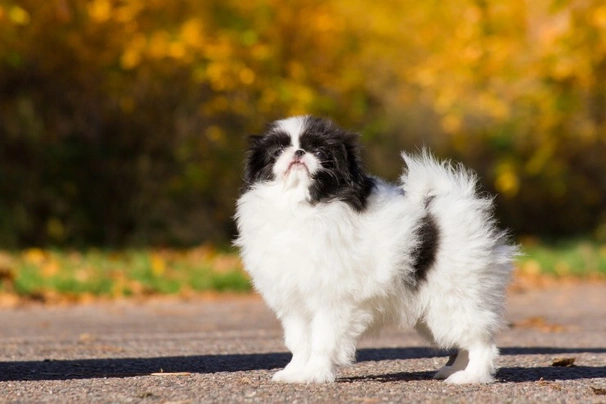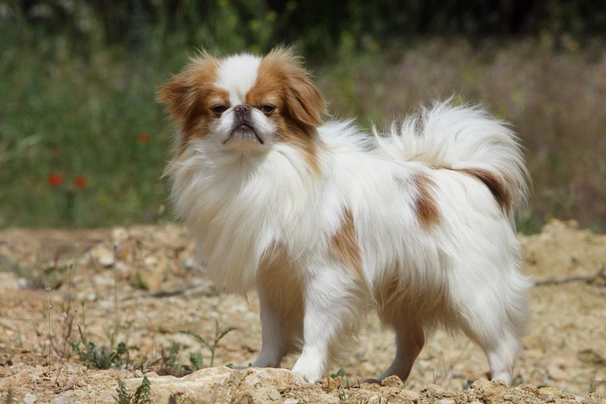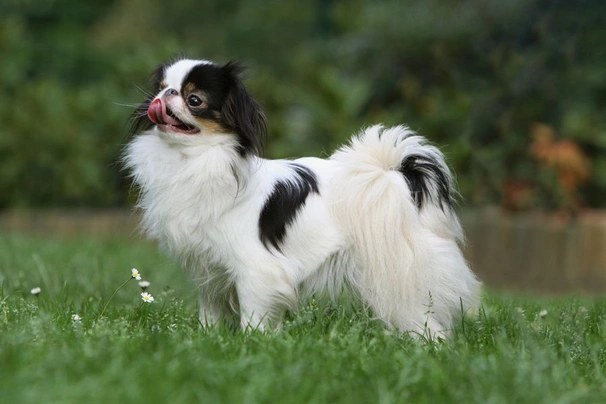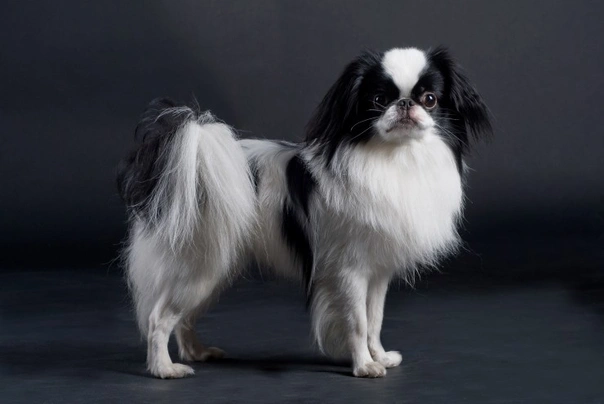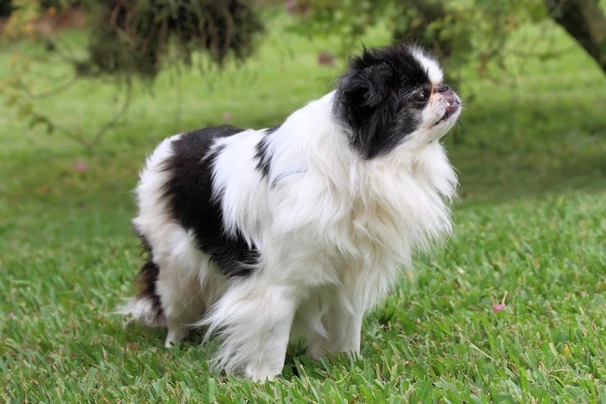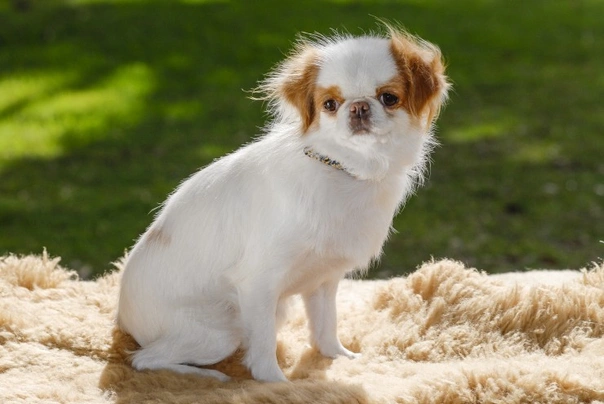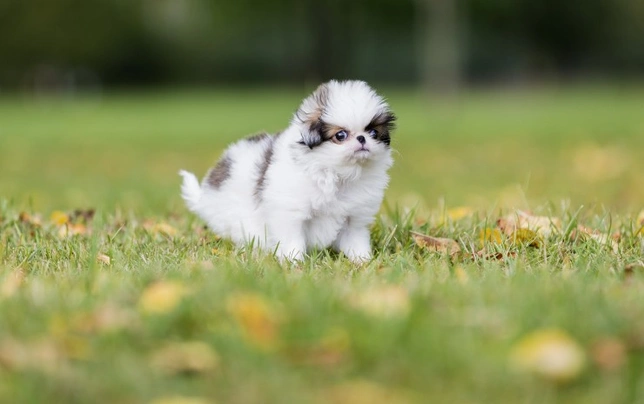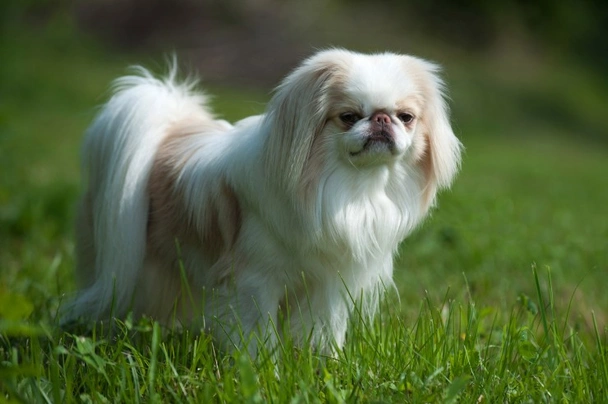Japanese Chin
Pros
Cons
Introduction of the Japanese Chin
The Japanese Chin is a dainty little dog and one that boasts having lots of presence. They are known to be very cat-like in their behaviours which sees them washing their faces using their paws a trait that makes them even more endearing. Although the Chin seems delicate they are far from having fragile personalities because they are bold intelligent and ultra-bright which are just a few more reasons why the breed has remained such a popular companion throughout the ages both in the UK and elsewhere in the world.
History of the Japanese Chin
Although the actual origins of the breed have been lost in time it's thought the Japanese Chin first originated in China but the breed found its way to Japan when the Empress of China offered one of these charming little dogs as a gift to the Empress of Japan. One thing that's for sure is these charming dogs boast being among one of the more ancient breeds to be found and that over the centuries they have remained highly prized. In days long past the breed was a little different to the dogs we see today because it's thought the original Japanese Chins were crossed with smaller spaniels with an end goal being to create the much-loved dogs of today.
At the time only Japanese nobility was permitted to own a Japanese Chin and each palace developed their own breed standards which as a result saw that bloodlines suffer because no outcrossing was allowed. This led to the breed suffering from hereditary health issues. With this said there were many different types of Chins at the time depending on which region of the country they were found in. There were certain traits and characteristics that were highly prized which includes dogs having chrysanthemum tails feathered feet and a thumbprint on the top of their heads. The most important trait at the time was for Chins to be as small as possible so they could be carried up kimono sleeves and in gilded cages.
The breed remained very much a "secret" outside of their native Japan right up until 1853 when the first foreign Portuguese traders arrived in the country. Chins were offered as gifts to Catherine of Braganza who was the Queen Consort of King Charles II. It is thought that these dogs may have been crossed with toy spaniels at the time. The Chin soon became a sought-after trading commodity and as such many of them found their way to other countries. These little dogs soon found favour with the wealthy and the nobility thanks to their charming looks and kind gentle and devoted natures.
A naval commodore by the name of Matthew Calbraith Perry was offered 7 Japanese Chins by the Emperor when he arrived in the country with many gifts. The commodore took them back with him but sadly only 2 dogs survived the journey and were given to Queen Victoria. Another two were offered as gifts to the President of the United States at the time namely Franklin Pierce. Over time their popularity grew with many famous people owning Japanese Chins.
Today Chins remain a popular choice both as companions and family pets but they are also often seen in the showring and are always a success with judges and breed enthusiasts alike. They are recognised by all the major international breed organisations which includes The Kennel Club.
Interesting facts about the breed
- Is the Japanese Chin a vulnerable breed? No they are becoming one of the more popular small breeds in the UK
- At one time only royals and the nobility could own a Japanese Chin in their native Japan
- There were 279 well-bred Japanese Chins registered with the Kennel Club in 2008 and breed numbers have continued to steadily rise
- Japanese Chins were popular with many royals and nobles which includes King Edward VIII's consort namely Queen Alexander
- Queen Victoria was offered 2 Japanese Chins
- President Franklin Pierce of American owned Japanese Chins
Appearance of the Japanese Chin
Height at the withers: Males 18 - 28 cm Females 18 - 28 cm
Average weight: Males 1.8 - 3.2 kg Females 1.8 - 3.2 kg
The Japanese Chin has a traditional Oriental look about them. They are delicate in appearance but quite robust by nature. They boast having an aristocratic elegant body that's covered with a profuse amount of soft and silky hair. Their heads are on the large size in relation to the rest of their bodies with dogs boasting broad skulls that are rounded at the front as well as between their ears without being domed. They have large black noses with wide open nostrils although lighter coloured dogs can have lighter coloured noses to match their coats. Muzzles are short and wide being well cushioned by nicely rounded lips.
They have moderately large dark eyes that are set wide apart on a dog's face. A little white can be seen in the inner corners of each eye which adds to their endearing looks. Their ears are V-shaped being well feathered and set wide apart and high on a dog's head. Ears are small which dogs carry a little forward. They have a level bite although some dogs have slightly undershot jaws which is acceptable. Necks are moderately long which dogs hold proudly. Their front legs are strong straight fine boned and well feathered right the way down to a dog's feet which adds to a Chin's slender and elegant appearance.
Chins have compact square bodies with wide chests which gives them their "cobby" look. Their hindquarters are strong with dogs having straight back legs when seen from behind while their feet are slender and quite hare-like being feathered at the tips. Tails are set high and profusely covered in feathers which dogs hold over their backs although some dogs carry their tails plumed over their backs.
When it comes to their coat the Japanese Chin boasts having a profuse soft long and straight coat that ultra-silky to the touch. The hair tends to form a type of frill around a dog's neck which adds to their unique look. The accepted breed colours for Kennel Club registration are as follows:
- Black & White
- Red & White
- Sable & White
- White & Black
Gait/movement
When a Japanese Chin moves they do with style moving in a straight line and showing a lot of reach when they do. Dogs must show absolute soundness with no weakness in their hindquarters being evident.
Faults
The Kennel Club frowns on any exaggerations or departures from the breed standard and would judge the faults on how much they affect a dog's overall health and wellbeing as well as their ability to perform.
Males should have both testicles fully descended into their scrotums and it is worth noting that a dog can be a little lighter or heavier as well as slightly taller or shorter than set out in the Kennel Club breed standard which is given as a guideline only.
Temperament of the Japanese Chin
The Japanese Chin is known to be a happy affectionate and loyal little dog that gets on with everybody which includes people other dogs cats and animals. They make wonderful companions and family pets being better suited to households where the children are that much older and who therefore know how to handle such small dogs. They form extremely strong ties with their owners and thrive on being involved in everything that goes on around the home. However they can be a little shy around strangers preferring to keep their distance until they get to know someone but rarely would a Chin show any sort of aggressive behaviour towards anyone they don't already know.
Because of their small size they are the ideal choice of pet for people who live in apartments because they only need to be given a little in the way of daily exercise. However because they are so smart a Chin needs to be given a lot of mental stimulation to prevent boredom from setting in which could see dogs developing some unwanted and destructive behaviours around the home which is their way of relieving any stress they are feeling at not having something to occupy their minds.
They are known to be very sensitive little dogs which means they pick up on their owner's emotions very quickly. If everyone is being quiet around the home a Chin would typically follow suit but if things get lively these little dogs would quickly join in which are just some of the reasons why they have found their way into the hearts and homes of so many people around the world.
They are very cat-like in their behaviours and will clean themselves with their paws to make sure they are looking their best. They also enjoy lying on the backs of furniture and windowsills much like their feline counterparts. They are a great choice for first time owners because there is nothing Chins enjoy more than to please and being so smart they learn new things very quickly. They are also known to be quite talkative although they are not given to barking preferring to chatter away with their owners and any visitors that drop by.
It's important for these dogs to be well socialised from a young age so they grow up to be confident outgoing mature dogs. Their socialisation must include introducing them to lots of new situations noises people other animals and dogs once they have been fully vaccinated. It's also crucial for their training to start early too and it should be consistent throughout a dog's life. A Chin is never happier than when they know their place in the pack and who they can look to for direction and guidance. If they don't know who is the alpha dog in a household they may quickly take on the role of dominant dog.
If they are pampered a little too much a Chin could develop a condition known as "Small Dog Syndrome" which often sees dogs becoming neurotic and stressed out and therefore harder to handle and live with. In short it's important not to let a Chin get away with things that larger dogs would never be allowed to do.
Are they a good choice for first time owners?
Japanese Chins are the perfect choice for first time dog owners because they are so amenable and people-oriented loving nothing more than to please and to entertain their families. With this said they are better suited to families with older children rather than toddlers because they are so small and can be quite snappy if they feel threatened in any way.
What about prey drive?
Japanese Chins have a high prey drive and because they don't realise how small they are they will take on the world and give chase to any animal that tries to run away. As such care should always be taken as to where and when a Chin can run off the lead more especially if there are other animals around which includes larger dogs.
What about playfulness?
Chins have a very playful side to their natures and love to entertain and be entertained. They are known to be a little mischievous when the mood takes them and being clever they quickly learn what pleases an owner which they will use to get their own way whenever they can which typically involves some silly albeit charming antics.
What about adaptability?
Japanese Chins are highly adaptable dogs and providing they are given enough daily physical exercise combined with as much mental stimulation to prevent boredom from setting in they are just as happy living in an apartment in town as they are living in a house in the country.
What about separation anxiety?
Chins form extremely strong ties with their families and are never very happy when they find themselves left on their own. They are better suited to people who either work from home or in households where one person stays at home when everyone else is out so they are never alone for any length of time which could see a dog suffering from separation anxiety. This can lead to them being destructive around the home which is a dog's way of relieving any stress they are feeling and a way to keep themselves entertained.
What about excessive barking?
Some Chins are known to like the sound of their own voices a little too much which is something that needs to be gently nipped in the bud when a dog is still young being careful not to frighten them. However these little dogs are not known to be very vocal by nature.
Do Japanese Chins like water?
Most Chins are afraid of water and because they are so small and because they are a brachycephalic breed care should always be taken when they do go swimming because they could have trouble breathing. With this said anyone who owns a dog that does not like water should never force them to go in because it would just end up scaring them. With this said care should always be taken when walking a Chin off the lead anywhere near more dangerous watercourses just in case a dog falls in and then needs rescuing because they cannot get out of the water on their own.
Are Japanese Chins good watchdogs?
Chins may be small in stature but they are very effective watchdogs because they are always alert and ready to let an owner know when strangers are about and when something they don't like is happening around them. However rarely would a Chin go about their job aggressively preferring to keep their distance and bark as a way of alerting their owners.
Intelligence / Trainability of the Japanese Chin
The Chin is a smart little dog and a fast learner. The downside to this is they are just as quick to pick up bad habits as they are the good bearing in mind they are known to be a little wilful at times. Their training must start as soon as puppies arrive in their new home when they need to be taught the basics and boundaries. Their training also should consistent and always fair throughout a dog’s life so they understand what their owner expects of them. Chins are never happier than when they are given something to do which is why they are so amenable to learning new things. However they can be a little hard to housetrain which typically takes more time and a lot of patience and understanding than in other small breeds.
The key to successfully training a Chin is to make their training as interesting as possible and to avoid too much repetition. It's also a good idea to keep training sessions that much shorter which helps dogs stay more focused on what it’s being asked of them bearing in mind that the more intelligent a dog is the faster they get bored. They do not answer well to harsh correction or any sort of heavy handed training methods but they do respond extremely well to positive reinforcement which always brings the best out of these intelligent and quick-witted dogs especially when there are high value rewards involved.
Japanese Chin puppies are very cute and it is all too easy to spoil them when they first arrive in their new homes. However owners need to start out as they mean to go on which means setting out limits and ground rules right from the word go. This not only helps a dog understand what is acceptable behaviour and what is not but it also helps establish a pecking order with owners establishing themselves as the alpha dogs. Like many other small breeds if a Chin is spoiled and allowed to get away with things it can lead to them suffering from Small Dog Syndrome. This sees dogs being unruly and wilful making them harder to live with. The first commands a Chin puppy should be taught are as follows:
- Come
- Sit
- Stay
- Heel
- Quiet
- Leave it
- Down
- Bed
Children and other
Chins are generally fun-loving charming little dogs and they make wonderful companions and family pets. However they are not best suited to households where the children are that much younger and who therefore do not know how to handle such a small dog which in short means they might end up accidentally injuring a dog. They are a great choice for families where the children are older though.
When dogs have been well socialised from a young enough age they generally get on well with other dogs they meet but care must be taken when they are around larger dogs because of their small stature. If they have grown up with a family cat in a household they usually get on well together. However a Chin would think nothing of chasing off any other cats they encounter because they would see them as fair game. Care should be taken when they are around any smaller animals and pets just to be safe.
Health of the Japanese Chin
The average life expectancy of a Japanese Chin is between 10 and 12 years when properly cared for and fed an appropriate good quality diet to suit their ages.
The Chin is known to suffer from a few hereditary health issues which are worth knowing about if you are planning share your home with one of these charming and charismatic little dogs. The conditions that seem to affect the breed the most include the following:
- Congenital deafness - BAER test available through the Animal Health Trust (AHT)
- Progressive retinal atrophy (PRA) - Breeders should have stud dogs eye tested
- Gangliosidosis GM2
- Luxating patellas
- Atlantoaxial subluxation of the cervical spine
- Entropion (Eyelids Folding Inwards)
- Eye ulcerations
- Atrioventricular Endocardiosis
- Legg-Calve-Perthes Disease
- Skin allergies
- Breathing difficulties
- Heart murmurs
- Cataracts
What about vaccinations?
Chin puppies would have been given their initial vaccinations before being sold but it is up to their new owners to make sure they have their follow-up shots in a timely manner with the vaccination schedule for puppies being as follows:
- 10 -12 weeks old bearing in mind that a puppy would not have full protection straight away but would be fully protected 2 weeks after they have had their second vaccination
There has been a lot of discussion about the need for dogs to have boosters. As such it's best to talk to a vet before making a final decision on whether a dog should continue to have annual vaccinations which are known as boosters.
What about spaying and neutering?
A lot of vets these days recommend waiting until dogs are slightly older before spaying and neutering them which means they are more mature before undergoing the procedures. As such they advise neutering males and spaying females when they are between the ages of 6 to 9 months old and sometimes even when a dog is 12 months old.
Other vets recommend spaying and neutering dogs when they are 6 months old but never any earlier unless for medical reasons. With this said many breeds are different and it is always advisable to discuss things with a vet and then follow their advice on when a dog should be spayed or neutered.
What about obesity problems?
Some Chins gain weight after they have been spayed or neutered and it's important to keep an eye on a dog's waistline just in case they do. If a dog starts to put on weight it's important to adjust their daily calorie intake and to up the amount of exercise they are given. Older dogs too are more prone to gaining weight and again it's essential they be fed and exercised accordingly because obesity can shorten a dog's life by several years. The reason being that it puts a lot of extra strain on a dog's internal organs including the heart which could prove fatal.
What about allergies?
Chins are prone to suffering from allergies and it's important for a dog to see a vet sooner rather than later if one flares up. Allergies can be notoriously hard to clear up and finding the triggers can be challenging. With this said a vet would be able to make a dog with an allergy more comfortable while they try to find out the triggers which could include the following:
- Certain dog foods that contain high levels of grain and other cereal fillers
- Airborne pollens
- Dust mites
- Environment
- Flea and tick bites
- Chemicals found in everyday household cleaning products
Participating in health schemes
All responsible Japanese Chin breeders would ensure that their stud dogs are tested for known hereditary and congenital health issues known to affect the breed by using the following schemes:
- Heart testing - tests are available at Championship shows and through other organisations like the Animal Health Trust
- Eye testing - breeders and owners can have dog's tested by ophthalmologists who are registered with the Kennel Club under the KC/BVA eye scheme
- Congenital deafness - dogs should be BAER tested
What about breed specific breeding restrictions?
Apart from the standard breeding restrictions for all Kennel Club registered breeds there are currently no other breed specific breeding restrictions for the Japanese Chin.
What about Assured Breeder Requirements?
Currently there are not KC or British Veterinary Association DNA tests or screening schemes available for the Japanese Chin under the KC Assured Breeder Scheme. Prospective owners however should ask breeders about relevant tests available for the breed.
Caring for the Japanese Chin
As with any other breed Chins need to be groomed on a regular basis to make sure their coats and skin are kept in top condition. They also need to be given regular daily exercise to ensure they remain fit and healthy. On top of this dogs need to be fed good quality food that meets all their nutritional needs throughout their lives.
Caring for a Japanese Chin puppy
Japanese Chin puppies are boisterous and full of life which means it's essential for homes and gardens to be puppy-proofed well in advance of their arrival. A responsible breeder would have well socialised their puppies which always leads to more outgoing confident and friendly dogs right from the word go. With this said any puppy is going to feel vulnerable when they leave their mother and littermates which must be taken into account. The longer a puppy can remain with their mother the better although it should never be for too long either.
It's best to pick a puppy up when people are going to be around for the first week or so which is the time needed for a puppy to settle in. Puppy-proofing the home and garden means putting away any tools and other implements that a boisterous puppy might injure themselves on. Electric wires and cables must be put out of their reach because puppies love chewing on things. Toxic plants should be removed from flowerbeds and the home too.
Puppies need to sleep a lot to grow and develop as they should which means setting up a quiet area that's not too out of the way means they can retreat to it when they want to nap and it's important not to disturb them when they are sleeping. It's also a good idea to keep "playtime" nice and calm inside the house and to have a more active "playtime" outside in the garden which means puppies quickly learn to be less boisterous when they are inside.
The documentation a breeder provides for a puppy must have all the details of their worming date and the product used as well as the information relating to their microchip. It is essential for puppies to be wormed again keeping to a schedule which is as follows:
- Puppies should be wormed at 6 months old
- They need to be wormed again when they are 8 months old
- Puppies should be wormed when they are 10 months old
- They need to be wormed when they are 12 months old
Things you'll need for your puppy
There are certain items that new owners need to already have in the home prior to bringing a new puppy home. It's often a good idea to restrict how much space a puppy plays in more especially when you can't keep an eye on what they get up to bearing in mind that puppies are often quite boisterous which means investing in puppy gates or a large enough playpen that allows a puppy the room to express themselves while keeping them safe too. The items needed are therefore as follows:
- Good quality puppy or baby gates to fit on doors
- A good well-made playpen that's large enough for a puppy to play in so they can really express themselves as puppies like to do
- Lots of well-made toys which must include good quality chews suitable for puppies to gnaw on bearing in mind that a puppy will start teething anything from when they are 3 to 8 months old
- Good quality feed and water bowls which ideally should be ceramic rather than plastic or metal
- A grooming glove
- A slicker brush or soft bristle brush
- Dog specific toothpaste and a toothbrush
- Scissors with rounded ends
- Nail clippers
- Puppy shampoo and conditioner which must be specifically formulated for use on dogs
- A well-made dog collar or harness
- A couple of strong dog leads
- A well-made dog bed that's not too small or too big
- A well-made dog crate for use in the car and in the home that's large enough for a puppy to move around in
- Baby blankets to put in your puppy's crate and in their beds for when they want to nap or go to sleep at night
Keeping the noise down
All puppies are sensitive to noise including Japanese Chin puppies. It's important to keep the noise levels down when a new puppy arrives in the home. TVs and music should not be played too loud which could end up stressing a small puppy out.
Keeping vet appointments
As previously mentioned Chin puppies would have been given their first vaccinations by the breeders but they must have their follow up shots which is up to their new owners to organise. The vaccination schedule for puppies is as follows:
- 10 -12 weeks old bearing in mind that a puppy would not have full protection straight away but would only be fully protected 2 weeks after they have had their second vaccination
When it comes to boosters it's best to discuss these with a vet because there is a lot of debate about whether a dog really needs them after a certain time. However if a dog ever needed to go into kennels their vaccinations would need to be fully up to date.
What about older Japanese Chins when they reach their senior years?
Older Chins need lots of special care because as they reach their golden years they are more at risk of developing certain health concerns. Physically a dog's muzzle may start to go grey but there will be other noticeable changes too which includes the following:
- Coats become coarser
- A loss of muscle tone
- Chins can either become overweight or underweight
- They have reduced strength and stamina
- Older dogs have difficulty regulating their body temperature
- They often develop arthritis
- Immune systems do not work as efficiently as they once did which means dogs are more susceptible to infections
- Older dogs change mentally too which means their response time tends to be slower as such they develop the following:
- They respond less to external stimuli due to impaired vision or hearing
- They tend to be a little pickier about their food
- They have a lower pain threshold
- Become intolerant of any change
- Often an older dog can feel disorientated
Living with a Japanese Chin in their golden years means taking on a few more responsibilities but these are easily managed and should include taking a look at their diet the amount of exercise they are given how often their dog beds need changing and keeping an eye on the condition of their teeth.
Older Chins need to be fed a good quality diet that meets their needs at this stage of their lives all the while keeping a close eye on a dog's weight. A rough feeding guide for older dogs is as follows bearing in mind they should be fed highly digestible food that does not contain any additives:
- Protein content should be anything from 14 – 21%
- Fat content should be less than 10%
- Fibre content should be less than 4%
- Calcium content should be 0.5 – 0.8%
- Phosphorous content should be 0.4 – 0.7%
- Sodium content should be 0.2 – 0.4%
Older Japanese Chins don't need to be given the same amount of daily exercise as a younger dog but they still need the right amount of physical activity to maintain muscle tone and to prevent a dog from putting on too much weight. All dogs need access to fresh clean water and this is especially true of older dogs when they reach their golden years because they are more at risk of developing kidney disorders.
Grooming of the Japanese Chin
Chins have quite a profuse single coat but they are medium maintenance on the grooming front. A daily brush is all it takes to keep things tidy and to prevent any knots or tangles from forming which rarely happens but it's best to keep an eye on things just in case. Special attention should be paid to the longer hair on a dog's ears legs bellies and tails. Their eyes also need to be wiped regularly to remove any moisture that may have built up under them which could provide the perfect environment for a fungal infection to take hold.
They shed steadily throughout the year only more so during the Spring and then again in the Autumn when more frequent grooming is usually necessary to stay on top of things and to remove dead and shed hair from a dog's coat. It's also important to check a dog's ears on a regular basis and to clean them when necessary. If too much wax builds up it can lead to a painful infection which can be hard to clear up. In short prevention is often easier than cure with ear infections.
Exercise of the Japanese Chin
The Japanese Chin is not a high energy dog but they still need the right amount of exercise every day combined with as much mental stimulation as possible to prevent them from getting bored. They need around 30 minutes a day with as much off the lead time as possible in a safe and secure environment. It's also important to invest in a harness rather than use a collar on a Chin because their necks are so fragile.
If Chins are not given the right amount of mental stimulation and exercise every day they would quickly get bored and could even begin to show some destructive behaviours around the home which is their way of relieving any stress they are feeling and not necessarily because they are being naughty.
A shorter walk in the morning would be fine but a longer more interesting one in the afternoon is a must with as much off the lead time as possible. These dogs also like to be able to roam around a back garden so they can really let off steam. However the fencing must be extremely secure to keep these active little dogs in because if they find a weakness in the fence they will soon escape and could get into all sorts of trouble.
With this said Chin puppies should not be over exercised because their joints and bones are still growing. This includes not letting a dog jump up and down from furniture or going up or down the stairs. Too much pressure placed on their joints and spines at an early age could result in a dog developing serious problems later in their lives.
Feeding of the Japanese Chin
If you get a Chin puppy from a breeder they would give you a feeding schedule and it's important to stick to the same routine feeding the same puppy food to avoid any tummy upsets. You can change a puppy's diet but this needs to be done very gradually always making sure they don't develop any digestive upsets and if they do it's best to put them back on their original diet and to discuss things with the vet before attempting to change it again.
Older dogs are not known to be fussy eaters and it's best not to pander to them if they refuse to eat their food and to check it's not because they are ill which could mean visit to the vet. Mature dogs need to be fed twice a day once in the morning and then again in the evening making sure it's good quality food that meets all their nutritional requirements. It's also important that dogs be given the right amount of exercise so they burn off any excess calories or they might gain too much weight which can lead to all sorts of health issues. Obesity can shorten a dog's life by several years so it's important to keep an eye on their waistline from the word go.
Feeding guide for a Japanese Chin puppy
Puppies need to be fed a highly nutritious good quality diet for them to develop and grow as they should. As a rough guide a Chin puppy can be fed the following amounts every day making sure their meals are evenly spread out throughout the day and it's best to feed them 3 or 4 times a day:
- 2 months old - 43g to 63g depending on puppy's build
- 3 months old - 51g to 71g depending on puppy's build
- 4 months old - 55g to 75g depending on puppy's build
- 5 months old - 55g to 75g depending on puppy's build
- 6 months old - 48g to 68g depending on puppy's build
- 7 months old - 41g to 61g depending on puppy's build
- 8 months old - 34g to 54g depending on puppy's build
- 9 months old - 33g to 53g depending on puppy's build
- 10 months old - 33g to 53g depending on puppy's build
Once a puppy is 11 months old they can be fed adult dog food.
Feeding guide for an adult Japanese Chin
Once fully mature an adult Chin must be fed a good quality diet to ensure their continued good health. As a rough guide an adult Japanese Chin can be fed the following amounts every day:
- Dogs weighing 1.8 kg can be fed 40g to 47g depending on activity
- Dogs weighing 2.5 kg can be fed 45g to 52g depending on activity
- Dogs weighing 3.2 kg can be fed 55g to 63g depending on activity
Japanese Chin price
If you are looking to buy a Japanese Chin you would need to pay anything from £500 to over £600 for a well-bred pedigree puppy. The cost of insuring a male 3-year-old Chin in northern England would be £24.18 a month for basic cover but for a lifetime policy this would set you back £52.12 a month (quote as of February 2018). When insurance companies calculate a pet's premium they factor in several things which includes where you live in the UK a dog's age and whether they have been neutered or spayed among other things.
When it comes to food costs you need to buy the best quality food whether wet or dry making sure it suits the different stages of a dog’s life. This would set you back between £20 - £30 a month. On top of this you need to factor in veterinary costs if you want to share your home with a Chin and this includes their initial vaccinations their annual boosters the cost of neutering or spaying a dog when the time is right and their yearly health checks all of which quickly adds up to over £900 a year.
As a rough guide the average cost to keep and care for a Japanese Chin would be between £50 to £90 a month depending on the level of insurance cover you opt to buy for your dog but this does not include the initial cost of buying a healthy well-bred Kennel Club registered pedigree Japanese Chin puppy.
Buying advice
When visiting and buying any puppy or dog there are many important things to consider and questions to ask of the breeder/seller. You can read our generic puppy/dog advice here which includes making sure you see the puppy with its mother and to verify that the dog has been wormed and microchipped.
Japanese Chins have become a popular small breed both in the UK and elsewhere in the world which means that well-bred health Kennel Club registered puppies can often command a lot of money. As such with Japanese Chins there is specific advice questions and protocols to follow when buying a puppy which are as follows:
- Beware of online scams and how to avoid them. You may see online and other adverts by scammers showing images of beautiful Japanese Chinpuppies for sale at very low prices. However the sellers ask buyers for money up front before agreeing to deliver a puppy to a new home. Potential buyers should never buy a puppy unseen and should never pay a deposit or any other money online to a seller. You should always visit the pet at the sellers home to confirm they are genuine and make a note of their address.
- As previously touched upon Japanese Chins have fast become one of the more popular small breeds in the UK. As such there are many amateur breeders/people who breed from a dam far too often so they can make a quick profit without caring for the welfare of the puppies their dam or the breed in general. Under Kennel Club rules a dam can only produce 4 litters and she must be between a certain age to do so. Anyone wishing to buy a Japanese Chin puppy should think very carefully about who they purchase their puppy from and should always ask to see the relevant paperwork pertaining to a puppy's lineage their vaccinations and their microchipping.
- Prospective owners should be very careful when considering buying a Japanese Chin puppy or dog that shows any sort of exaggeration in conformation with absolute soundness being essential. Extra-small Chins often suffer from health issues associated with their size and responsible breeders would never intentionally attempt to breed dogs that are too small for this very reason.

Japanese Chin
£600
